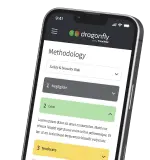‘Conversion rate’ on a website refers to the amount of website visitors that actually ‘convert’ to a paying customer via your website, or that engage with your primary 'call to action'. The importance of this speaks for itself, and if done properly, your website can become a seamless sales tool that works for you 24 hours a day, 7 days a week.
Your website conversion rate can be measured by dividing the number of customers who have completed a transaction, by the total number of website visitors on a page by page basis. Remember, improving this rate can also have a positive effect on your overall website traffic. We see many websites that have all of the bells and whistles and incorporate contemporary design, but they still don’t seem to convert enough sales, if you have a similar problem, read on to pick up some top tips.
Here is a list of techniques and changes that you can employ to boost conversions and make sure your website is performing for your business:
1) Run A/B tests
A/B testing is where you create 2 similar pages with different content or ‘Calls to actions’, direct 50% to page A, 50% to page B and measure the success of each page. The page that generates more results wins. As an example, you could create 2 versions of a homepage and promote different products, this should give you a good idea of which pages is more successful.
Top tip when A/B testing: Try to test one difference at a time. If you change lots of things with each test then it may be difficult to identify and measure which change delivered the results.
2) Keep the most important elements ‘Above the Fold’
‘Above the fold’ refers to the portion of the website that is visible without scrolling. Many studies have shown that most website visitors do not actually scroll down the page, especially if they don’t need to, so what is added above the fold is very important. This should have prominence on enquiry forms, contact details, core product offerings and value propositions.
3) Make it easy to buy from you
If someone is looking to buy your product or service, make sure that the process is as easy as possible. Ask yourself one simple question – would someone not familiar with technology be able to buy from you within a matter of minutes. Take these simple steps into consideration when making your site easy to buy from:
Guide the user – Tell them what they should do next, make the primary action or next step look more important than other areas of the site,
Don’t overcrowd – Try not to give the user too many options, this can cause confusion and actually deter a customer from buying. If you sell products, create better filters so that customers can find what they want in as little time as possible.
Don’t force users to sign up – Give users the option to buy or browse the site as a guest, if they like your services, they will more than likely join as a member later on. If you force them to sign up, this can just cause frustration and a lost sale.
4) Incorporate Mobile responsive design
The number of mobile surfers surpassed the number of desktop users in 2014, this is hugely important in 2016 as this is a trend that is estimated to increase even further going into the future. So this is now more critical to business success than ever. Mobile optimised websites are now prioritised over desktop searches when using search engines. Usability is also key here, ensuring that your customers have a good experience with your website - you want to make it as easy as possible for the customer to buy from you, and ask them to fill as few fields as possible. Non optimised sites viewed on mobile makes the text difficult to read and images harder to see as well as the customer clicking on the wrong links. When a customer becomes frustrated, they will leave and go to a competitor.
5) Install analytics
Analytics is a really effective way to gain an insight into user behaviour on your website – It can be used to see how many visitors have come to your site, what devices and browsers they are viewing your website on, how long they have spent on certain pages, and more importantly where your traffic is coming from, such as search engines, advertising banners, email campaigns, and social media just to name a few. It is also a really effective way to get an overall picture of your website ‘Bounce rate’ (which is the percentage of customers that visit one page and then leave without looking at any other pages) this can help you become more targeted in your product or service offering and improve the user journey
6) Optimise page load times
You only have a few short seconds for your page to load and engage your user before they lost interest and click away from your site. Research from KISS Metrics shows that 47% of uses expect a website to load within two seconds, and that each 1 second delay in loading speed reduces conversions by 7%! Run your website through Google's page speed tool to get some ideas as to where speed improvements can be made on your website.
7) Create well single-purpose landing pages
Create pages with the goal of giving the customer the core information they need to convert, and don't dilute this messaging. Be really clear as to what it is you are selling, and why the customer should engage with your call to action whether that be to buy or simply get into contact with you.
We would recommend doing a 'need, feature, benefit' analysis to identify the on page messaging. I.e. What need does the customer have, in our business this may be the case that the customer needs a platform to promote themselves; Then thing about the feature, which in our case would be the website itself; now finally think of the benefit, which for a site could be to attract new customers and win more business. Put all of these things together to identify what your true value proposition is to the end customer.
8) Incorporate video
Video can play a crucial role in increasing conversion rates on your website. Abedeen Group conducted a study that found that conversion rates were increased from 2.9% to 4.8% when pages contained a well-made video selling the concept. That's a whopping 65% increase in conversions!
9) Have a well-constructed about page
Having a comprehensive about page is important, it is the place that your users will often go too should they want to learn more about your organisation. It is particularly important if you sell a high value product or service as in these cases users are likely to spend a great deal of time researching before they buy.
10) Handle objections
As you position your pages to a visitor to your site you need to be asking yourself what is going through their head, as they won't just blindly buy into the concepts that you are presenting to them. Objections are those instinctive thoughts and feelings that a visitor may have that risk swaying them away from engaging with your call to action. Objects may include: Will I be sent spam messages? Is it free? Is this company credible and can I trust them? Do I need this? will this improve my position?
You should construct your messaging and page content to handle these objections. It could be that you show trust logos; emphasis that it is free; or present customer testimonials where other people counter the objections for you.
11) Design your page based on user behaviour
If you are an English speaker then you always read a book from left to right, right? Well so does everyone else, and this habitual, engrained behaviour effects how people engage with your web based content. The Neilson Norman group conducted an eye-tracking study that showed that users eyes typically follow an 'F' shape pattern across a page. They found that users won't read your text thoroughly, and instead will scan in this pattern to pick out the information that is key to them. The first two paragraphs are absolutely critical, and should contain the most important information related to the current page. Also interestingly the third word on any given line gets much less visual attention than the first two words.
Conclusion
We hope that this article has been helpful and guides you on the way to improving your own website to convert more users. If for any reason, you would like some advice around this, or need a new website or mobile application to sell your products or services, please get in touch for a chat.

